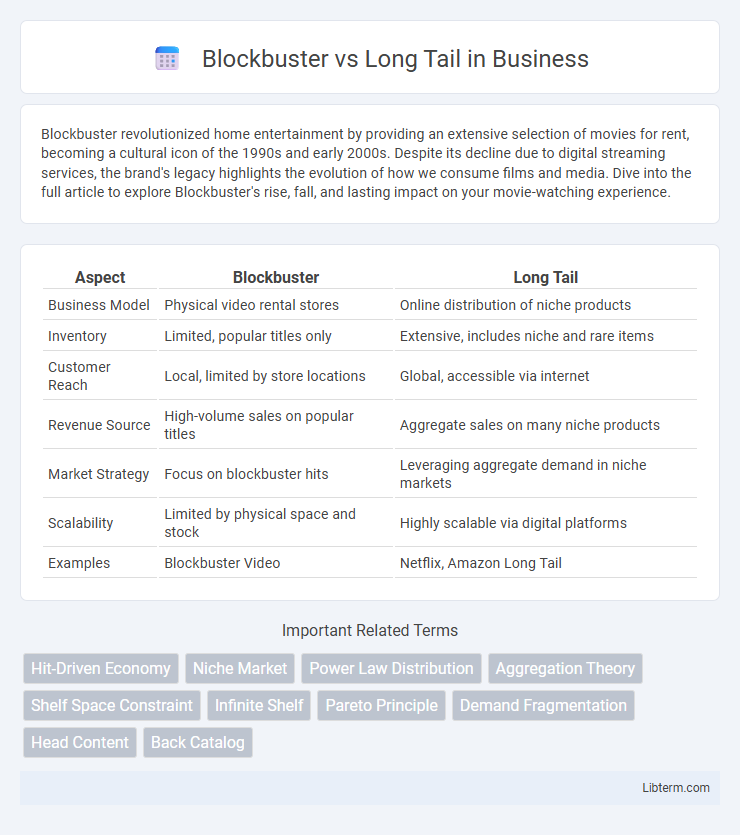Blockbuster revolutionized home entertainment by providing an extensive selection of movies for rent, becoming a cultural icon of the 1990s and early 2000s. Despite its decline due to digital streaming services, the brand's legacy highlights the evolution of how we consume films and media. Dive into the full article to explore Blockbuster's rise, fall, and lasting impact on your movie-watching experience.
Table of Comparison
| Aspect | Blockbuster | Long Tail |
|---|---|---|
| Business Model | Physical video rental stores | Online distribution of niche products |
| Inventory | Limited, popular titles only | Extensive, includes niche and rare items |
| Customer Reach | Local, limited by store locations | Global, accessible via internet |
| Revenue Source | High-volume sales on popular titles | Aggregate sales on many niche products |
| Market Strategy | Focus on blockbuster hits | Leveraging aggregate demand in niche markets |
| Scalability | Limited by physical space and stock | Highly scalable via digital platforms |
| Examples | Blockbuster Video | Netflix, Amazon Long Tail |
Introduction to Blockbuster vs Long Tail
Blockbuster products dominate markets by generating high sales volumes and widespread popularity, often driving significant revenue through mass appeal. In contrast, the Long Tail model thrives by catering to niche markets and diverse consumer preferences, capitalizing on the aggregate demand for less popular or specialized items. Understanding the dynamics between Blockbuster hits and Long Tail offerings is essential for businesses aiming to balance mainstream success with niche market penetration.
Defining the Blockbuster Model
The Blockbuster model hinges on producing and marketing a small number of high-budget, high-profile products aimed at mass appeal to maximize revenue through wide distribution. This approach relies heavily on mainstream consumer demand and significant upfront investments in advertising and production, often seen in Hollywood films and major music releases. Its success is dictated by capturing large audience segments quickly, differentiating it from niche-focused strategies like the Long Tail model.
Understanding the Long Tail Concept
The Long Tail concept emphasizes the economic value of selling a large number of niche products, each with relatively low demand, instead of focusing solely on a few blockbuster hits. This model leverages digital platforms and reduced distribution costs to offer extensive product variety, enabling consumer access to rare or less popular items. Understanding the Long Tail is crucial for businesses aiming to maximize revenue by tapping into diverse markets beyond mainstream blockbusters.
Historical Context and Market Evolution
Blockbuster dominated the video rental market during the 1990s by leveraging a broad inventory of mainstream, high-demand titles to attract mass audiences. The emergence of digital platforms and the Long Tail theory shifted consumer preferences towards niche and diverse content, enabled by lower distribution and storage costs. This market evolution diminished the viability of Blockbuster's blockbuster-focused model, paving the way for on-demand streaming services to capture long-tail market segments effectively.
Key Differences Between Blockbuster and Long Tail Strategies
Blockbuster strategy concentrates on a limited number of high-demand products targeting mass markets, aiming for maximum revenue from top hits. Long Tail strategy focuses on offering a vast variety of niche products, leveraging cumulative sales from lower-demand items to generate substantial market share. Key differences include inventory scope, marketing focus, and revenue distribution, with Blockbuster relying on hit-driven sales and Long Tail emphasizing diverse, low-volume products.
Impact on Consumer Choice and Behavior
Blockbuster hits dominate consumer attention by leveraging mass appeal and widespread marketing, driving high immediate sales through familiar, popular titles. In contrast, the long tail phenomenon expands consumer choice by offering niche content, allowing for personalized consumption patterns that cater to diverse preferences beyond mainstream blockbusters. This shift fosters a more dynamic marketplace where consumer behavior evolves toward exploring lesser-known works, influencing demand distribution and content availability.
Case Studies: Successes and Failures
Blockbuster's failure to adapt to the Long Tail model, as demonstrated by its decline amid Netflix's rise, highlights the risks of relying solely on blockbuster hits rather than a diverse content library. Netflix's success story exemplifies the Long Tail strategy, leveraging data-driven recommendations and extensive niche content that catered to varied consumer preferences beyond mainstream hits. Conversely, companies like Borders faltered by underestimating the Long Tail's impact, failing to integrate digital and long-tail inventory, which led to their eventual bankruptcy despite initial retail success.
Role of Technology and Digital Platforms
Digital platforms and technology redefine the Blockbuster vs Long Tail dynamics by enabling broader access to niche markets and personalized content delivery. Streaming services leverage algorithms and big data analytics to recommend diverse titles beyond mainstream hits, expanding consumer choice and increasing long-tail revenue opportunities. This technological shift diminishes the dominance of blockbuster hits by fostering visibility for lesser-known, specialized content across global audiences.
Implications for Content Creators and Businesses
Blockbuster hits dominate revenue streams through widespread appeal and high marketing budgets, often overshadowing niche content with smaller, dedicated audiences characteristic of the Long Tail model. Content creators face pressure to produce commercially viable blockbusters to secure funding and distribution, while innovative or specialized productions struggle to gain visibility and monetize effectively. Businesses must balance investing in blockbuster projects for immediate returns with leveraging digital platforms to exploit the Long Tail, targeting diverse consumer preferences and generating sustainable, long-term revenue across varied content portfolios.
Future Trends: Blockbuster, Long Tail, or Hybrid?
Future trends indicate a shift towards hybrid models that combine blockbuster hits with long tail offerings to maximize market reach and revenue. Streaming platforms and digital marketplaces leverage data analytics to balance high-demand content with niche selections, catering to diverse consumer preferences. This integrated approach enhances content discovery and monetization, positioning the entertainment industry for sustained growth.
Blockbuster Infographic

 libterm.com
libterm.com